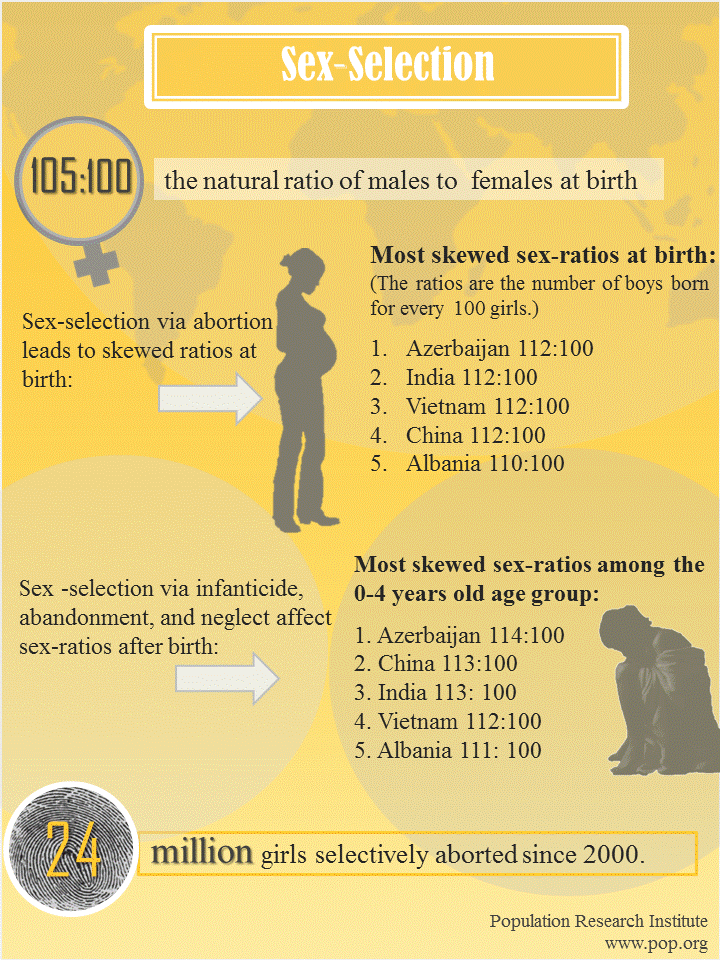Protect Girls from Sex-Selective Abortion
The Problem
According to UN statistics, there are 117 million girls missing around the world. Where have they gone? Many of them are left on the sides of roads, drowned, maimed and thrown in trash bins. But even more of them have been aborted.
The reason? They were girls, not boys.
Sex-selective abortion, also colloquially known as “gendercide,” is a huge problem across Asia. A traditional preference for sons, combined with harsh population control measures, has led to the wholesale destruction of little girls. This destruction that has left places like China in demographic turmoil, as young men are beginning to outnumber young women by substantial margins.
With immigration, the problem is also beginning to spread to the United States, as well.
How many sex-selective abortions are happening around the world?
Sex-Selective Abortion Around the World
More about the numbers
Where did you get these numbers?
The raw numbers (the sex-ratios and number of births) came from the U.S. Census Bureau.
We downloaded our data from the years 2000-2014. We then controlled for life expectancy and calculated the expected natural sex-ratio for each country in each given year.*
Using these numbers, we calculated from the number of babies born each year, how many male babies should have been born and how many female babies should have been born. We then used the actual sex-ratio to determine the number of male and female births in each country in each year.
We then took the difference between the number of girls that should have been borne given the country’s natural sex ratio and the number of girls that were actually born. We use this number as an estimate for how many girls were aborted because of their gender in each country by year.
There is a more in-depth explanation of the method we used in “Sex Selection in China and its Demographic Causes.”
The number of sex-selective abortions is different than the number of boy births more than girl births—why?
Our number is low: it only includes sex-selective abortions since the year 2000.
“24 million” doesn’t account for gender discrimination after birth.
Our number only includes numbers from societies where the problem is widespread:
Our figure does not include all girls who were aborted since the year 2000.

More numbers:
- Last year, there were 1,330,000 sex-selective abortions. There were also about 65,000,000 girls born last year (2013).
- For every 200 girls born, one is refused the chance to see the light of day just because she is a female.
- In the world’s two most populous countries, gender discrimination makes girls much less likely to ever see the light of day.
- In India, for every 100 girls who are born alive, 7 are aborted just because they are girls.
- In China, for every 100 girls who are born alive, 9 are aborted just because they are girls.
- Over the last 14 years, there were an average of 4,575 abortions every day. That comes to about one abortion motivated by gender every 18 seconds.
The Solution
Join the domestic and international effort to ban sex-selective abortion in our country and around the world.
Our president, Steve Mosher, testified before the Congressional sub-committee in opposition to Sex-Selective Abortion.
BILL STATUS: Feb. 16, 2012: Committee Consideration and Mark-up Session Held. (View full timeline.)
Our videos, press releases, and writings on the subject have helped inform the public about the seriousness of this problem. (See “Learn More”, below.)
You Can Help
- Contacting your Representatives and telling them to support H.R. 3541, the Pre-Natal Non-Discrimination Act.
- Raising awareness in your own community about sex-selective abortion, and
- Continuing to support our efforts against this expanding problem.
Learn More
- Watch PRI’s video coverage: Steve Mosher’s Congressional testimony for the Pre-Natal Non-Discrimination Act, Primer on sex-selective abortion
- Read PRI’s articles about sex selective abortion: Britain’s Problem With Sex Selective Abortions, Ban Sex Selective Abortions in the U.S., A New Front in the Abortion Wars, Sex-Selective Abortion Comes to America, Let Us Ban Sex-Selective Abortion.
- Read more media coverage: Gendercide (The Economist), Gendercide: The War Feminists Seemingly Refuse to Fight (Heritage Foundation)

